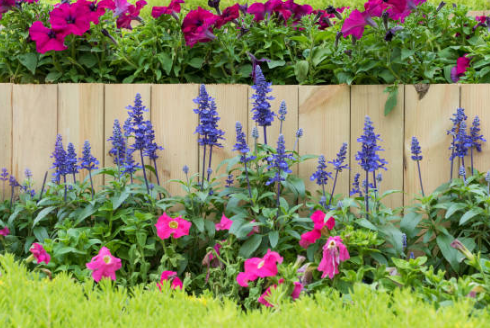A well-designed border garden can seamlessly blend with the hardscaping around it. These areas are typically planted with a mix of perennials and annuals and are designed to bring beauty, color, and continuity to your yard. Use the following tips to select and arrange the right plant combinations for a stunning border garden.
What Is a Border Garden?
As the name suggests, a border garden runs along the edges of buildings, walkways, fences, or other landscape features. In recent years, these gardens have also taken on an important role as habitats for wildlife—especially birds and pollinators like bees and butterflies. Many designers now choose to plant border gardens not just for their beauty, but also to support biodiversity.
Tips for Planting a Border Garden
1. Choose a Color Scheme
There are many ways to approach color in your border garden. Maybe you love the look of an all-white, elegant garden. Maybe you prefer bold, warm tones—or even want to reflect your favorite sports team’s colors!

A few things to keep in mind when selecting colors:
-
Consider nearby buildings. Is your house a light or dark color? Neutral or bright? Choose garden colors that contrast with the structure so they stand out instead of blending in.
-
Coordinate with the rest of your garden. If you’re going with a multicolored theme, keep it consistent across all visible areas. An all-white garden? Continue that theme throughout any adjacent beds.
-
Think about the color wheel. If you’re unsure what combinations work well, revisit the basics of the color wheel. Using adjacent (analogous) colors creates a calming look, while complementary (opposite) colors add energy and visual contrast.
2. Select Plants With Similar Needs
Planning a garden border isn’t just about how it looks—it also has to work. Be sure to choose plants that match your garden’s light and soil conditions. Do they all thrive in full sun or partial shade? Do they prefer well-drained soil or moist ground?
Grouping plants with similar requirements makes it easier to care for them and ensures they all thrive together.
3. Stagger Bloom Times
Border gardens are usually focused on color, often with flowering plants as the highlight. But most perennials don’t bloom nonstop all season. Many bloom for only a few weeks before setting seed or going dormant.
To keep your border colorful throughout the season:
-
Make a bloom timeline. Draw a line on paper to represent your growing season and mark which plants bloom when.
-
Fill the gaps. Look for species that bloom during the off-periods to ensure you always have something flowering. This benefits both the look of your garden and pollinators who rely on continuous bloom cycles.
4. Mix in Texture
After choosing your colors and bloom times, don’t forget about texture. Borders are a great opportunity to create visual interest and draw attention to the structure of the space.
Don’t focus only on flowers—consider leaf size, shape, and arrangement too. Try mixing broad, rounded leaves with narrow, spiky ones. For example, ornamental grasses add striking vertical lines that pair beautifully with curved pathways, while shade-loving plants with bold, fleshy leaves add softness and contrast.
5. Arrange Plants by Height
Think about the purpose of your border—are you creating privacy or simply defining space? Either way, plant height matters.
Generally, taller plants go in the back, and shorter plants go up front. Avoid placing tall varieties where they’ll block smaller ones, and make sure trailing or spreading plants don’t overwhelm ground covers.
6. Mix Annuals and Perennials
Many border gardens combine annuals and perennials. The mix you choose depends on your goals, budget, and how much effort you’re willing to invest.
-
Annuals need to be replanted each year, which takes more time and money. But they offer lots of color options and can refresh the look of your border.
-
Perennials require a larger upfront investment but will return year after year. They may need some seasonal care—like pruning or dividing—but they provide long-term structure and continuous habitat.
Remember, a border garden isn’t just a place to grow plants—it helps set the tone for your entire landscape. With thoughtful design, a border garden can become a haven for wildlife and a year-round highlight of your yard.

